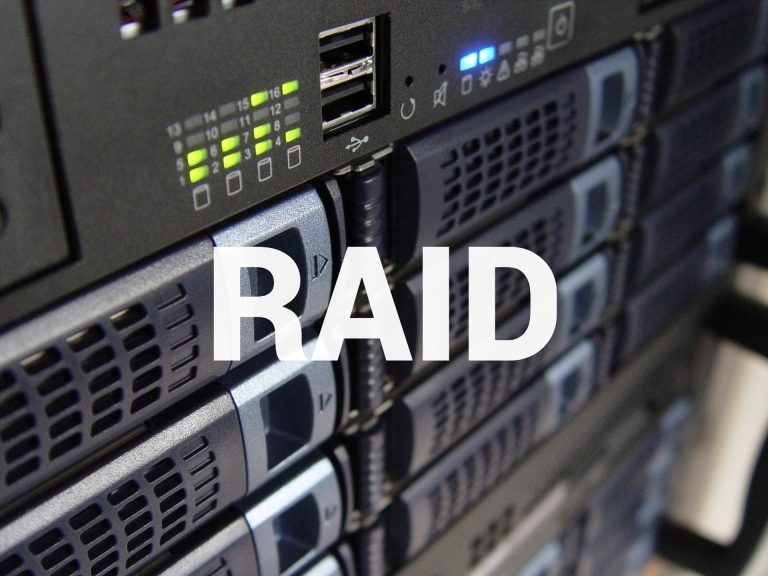
The RAID system improves reliability and performance by adding more redundancy to the data storage system. RAID stands for Redundant Array of Independent Drives or Redundant Array of Inexpensive Disks, which is the older version. In a RAID system, two or more hard drives work together to provide greater performance and capacity.
The four levels of RAID are most often used in most situations.
RAID 0 – striping
RAID 1 – mirroring
RAID 5 – striping with parity
RAID 10 – combining mirroring and striping
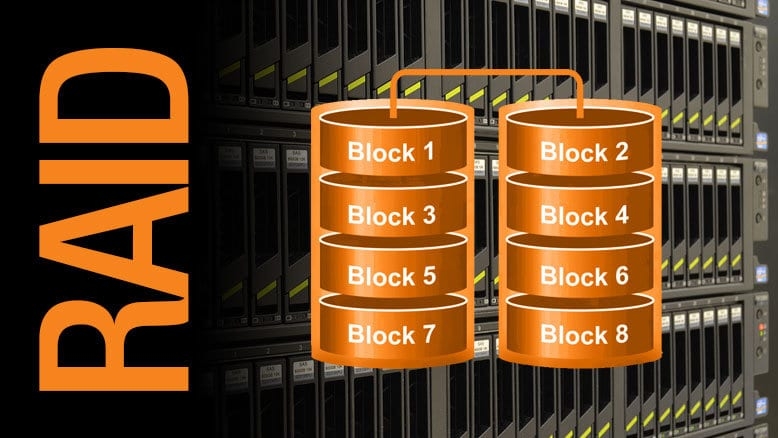
There are several RAID levels, each optimized for a particular situation. There is no industry group or standardization committee that standardized these.
A RAID system can use many types of interfaces, including SATA, SCSI, IDE, or FC (fiber channel). RAID systems use SATA disks internally, but this is done through a FireWire or SCSI interface on the host.
Explanation of RAID 0, 1, 5, & 10:
RAID 0 – Striping
The RAID 0 system is based on data striping. A data stream is broken down into multiple segments or blocks stored on different disks.
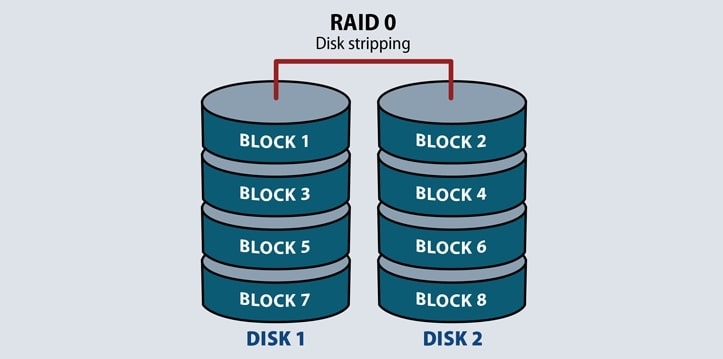
With RAID 0, you can write data on both drives simultaneously or sequentially, depending on your system if you have at least two drives. This will improve reading and writing speeds. However, If one of your drives fails, you will lose everything.
Data is divided into segments called striped units when you save a file in RAID 0. All of your array’s drives are then used to spread the data across them. This process is called striping, and it allows you to access data faster because multiple drives work together to read, write, and store data.
In RAID 0, you only need one hard drive to process data instead of multiple drives in an array, which is faster than getting a large hard drive with the same capacity.
There is no redundancy (or backup) in RAID 0. In other words, if one of your drives fails, you lose all your data. Because your data is stored and processed across multiple drives, losing the data on one drive means losing all of your data.
Moreover, since you are using multiple disks, the possibility that one will fail is increased. A RAID 0 array is best suited for storing temporary files or files backed up elsewhere.
RAID 1 – Mirroring
When data are written to both the data drive (or set of data drives) and the mirror drive (or set of drives), they are stored twice.
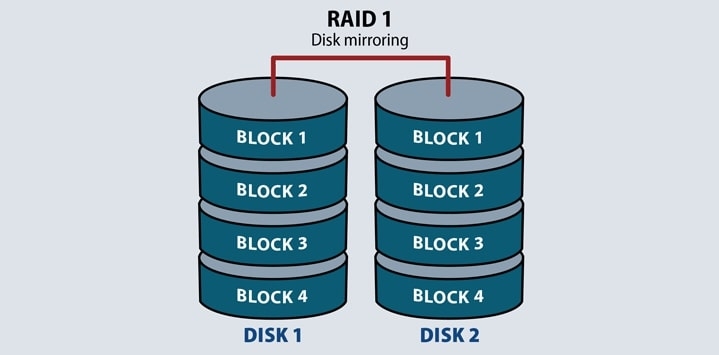
The controller uses either the data drive or the mirror drive for continuous operation if a drive fails. For a RAID 1 array, you need at least two drives.
Compared to RAID 0, which is primarily concerned with speed and performance, RAID 1 is primarily concerned with redundancy. A replica of the failed drive eliminates the possibility of data loss and downtime.
A further advantage of RAID 1 is its high read performance since all drives in the array can be read. The write speed is slower than a RAID 0 array, as the data needs to be written to all drives.
RAID 5 – Striping With Parity
A RAID 5 configuration is probably the most common RAID configuration, and unlike RAID 0 and RAID 1, it requires at least three disk drives to operate.
RAID 5 uses data striping, which separates data into segments and stores them on separate disk drives. Data for parity is not written to a fixed drive, it is spread across all drives.
The computer can recalculate the data of one of the other data blocks using the parity data if those data are no longer available. In other words, a RAID 5 array can withstand a drive failure without losing data or preventing access to it.
In the event of a disk drive failure, the parity checksums can be used to recreate the stored data.
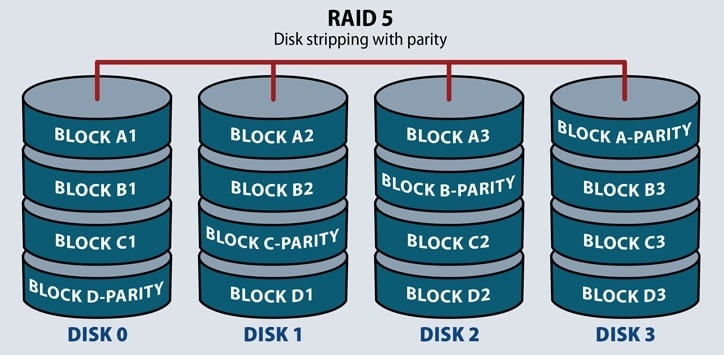
A disadvantage of RAID 5 is that it can only withstand the failure of one disk drive.
The RAID 5 array supports hot swapping, meaning one disk drive in the array can be replaced while the rest remain functional. Unfortunately, if a second disk drive fails while rebuilding the data from the first, all the data on that drive will be lost.
Regarding fault tolerance, RAID 5 surpasses RAID 0 and RAID 1 and has a higher total storage capacity.
Like RAID 0, RAID 5 read speeds are fast due to the concurrent output contributions from each drive. However, unlike RAID 0, RAID 5 write speeds are slower due to redundant parity checksum generation.
RAID 10 – Combining RAID 1 & RAID 0
The RAID 10 is part of the nested or hybrid RAID group, combining two different RAID levels striping and disk mirroring. As for RAID 10, the array combines mirroring at level 1 and striping at level 0. The RAID array is also called RAID 1+0.
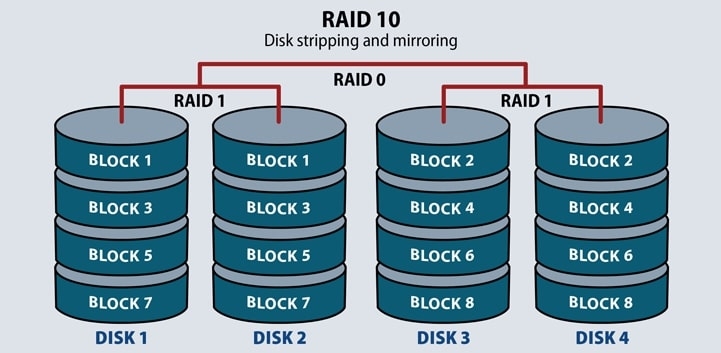
The data is segmented before being duplicated onto the drives in a RAID 10 configuration, which requires a minimum of four disks.
Likewise, the total storage capacity is halved when RAID 10 is configured with two disks, as with the standard RAID 1 configuration. In other words, you will only be able to use 3TB of storage from six 1TB disk drives.
A standard RAID 10 configuration with four disks can only tolerate one disk failure per pair of mirrored disks. Otherwise, all data is lost. A RAID 10 system offers the advantages of both RAID 0 and RAID 1, such as fast read and writes speeds and exceptional fault tolerance.
Compared to large RAID 5 or RAID 6 arrays, this is an expensive way to have redundancy.
Conclusion
Above, We’ve explained what Raid is and its different levels. Hopefully, you found this article helpful and useful. To develop a storage infrastructure that meets the needs of an organization, it is crucial to understand the RAID levels. RAID can increase performance and protect against disk failures.
But remember that it does not protect against data corruption or implement security capabilities. If you’ve any questions about this topic, please don’t hesitate to leave them in the comments box below. I’d be glad to assist you!
Directly in Your Inbox









